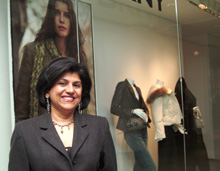Annamma Joy looks at the transformative experience

Annamma Joy studied the way we “consume” high fashion and high art.
Photo by Kate Hutchinson
Marketing professor Annamma Joy likes to approach a point from more than one angle. “For me, knowledge is always at the crossroads. What is interesting is, if you think of Venn diagrams, that middle there, where it overlaps.”
This approach has garnered her a three-year $85,000 Social Studies and Humanities Research Council grant to study “The Consumption of the Sacred and the Profane: The Blurring of Boundaries Between Museums and High Fashion Houses.”
She will visit New York, Milan and Tokyo, comparing the architecture and documenting these cultural institutions from the viewpoints of curators, directors, architects and consumers. Central to her study is the changing market, which is focused less on products and services and more on the merchandising of transformative experience.
Crossing boundaries excites her. Following early studies at the University of Madras, Joy obtained an MA and PhD in anthropology from the University of British Columbia. She came to Concordia more than 20 years ago to lecture on religion, and then went on to complete an MBA and the course work for a marketing doctorate. She has taught in the Marketing Department at the John Molson School of Business for 15 years.
She describes this study of museums and high fashion as a continuum. “Design is probably closest to the people, art is probably furthest from the people, and fashion is somewhere in between.”
Her perspective is informed by ethnographic notions of ritual, technique, the use of sacred time and space, and pilgrimage. She doesn't believe this “sacralization” is intentional on the part of the creators but that it is a by-product of the branding process, which is a form of public conversation.
"How do you create a luxury brand? What should you put in it that sets it apart? Anything set apart from the orginary becomes sacred in a society.”
Joy said her analysis is applicable to any brand, but especially the luxury brand. It generates the interest of top architects, brand managers and haute couture designers, who collaborate to create an experience.
Her approach is to interview cultural creators and consumers. She wrote a paper with John F. Sherry Jr. on the aesthetic experience that was published in the Journal of Consumer Research, where she now serves on the editorial board. That study analyzed the experience of museum visitors, and uncovered the resistance of some to the authority of the museum.
She said her students came back from a visit to a museum complaining that they felt restricted, even fearful because of the atmosphere. A visit to a museum should be “a joyful experience in a space full of creativity. Historically, museums have been seen as temples to art. When people talk there, they talk in whispers."
Cross-cultural study of consumer behaviour allows her to continue working with anthropologists and ethnologists. From 1996 to 1998, she worked in Hong Kong, and published a paper on gift-giving in that culture.
She would recommend the journey from anthropology to marketing to any student, “or to literature, fine arts, anything that can blow open your mind.” What is paramount is to cultivate “openness. . . a philosophy that tries to get you beyond appearances.”